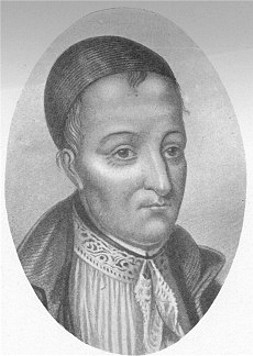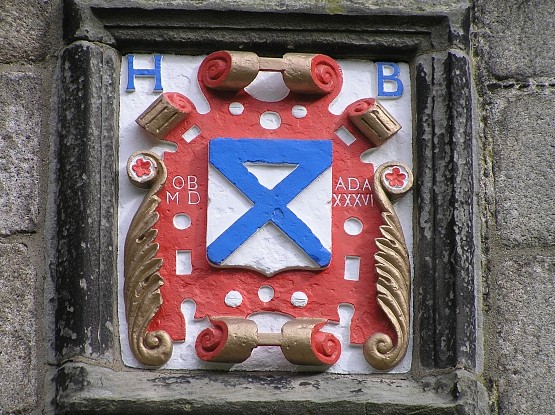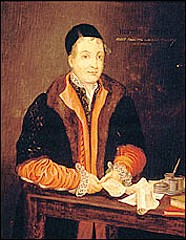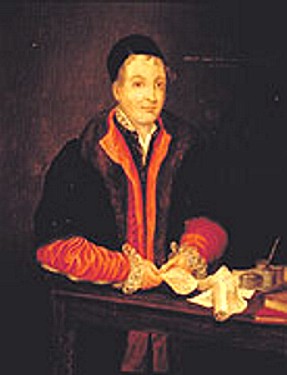Lessico
Hector
Boëce
Hector Boyce - Hector Boethius

Storiografo e umanista scozzese (Dundee 1465 - Aberdeen 1536) il cui
cognome venne latinizzato in Boethius ed essendo nato a Dundee assunse
il soprannome di Deidonanus. Studiò all'Università di
Parigi, dove conobbe Erasmo![]() . Fu poi il primo rettore del Trinity College di Aberdeen. Nei suoi
trattati ampio spazio è lasciato alla leggenda. Fra le opere: Episcoporum
Murthlacensium et Aberdonensium vitae (1522) contenente preziose notizie
sulla fondazione dell'Università di Aberdeen e Scotorum historiae a prima
gentis origine (1527).
. Fu poi il primo rettore del Trinity College di Aberdeen. Nei suoi
trattati ampio spazio è lasciato alla leggenda. Fra le opere: Episcoporum
Murthlacensium et Aberdonensium vitae (1522) contenente preziose notizie
sulla fondazione dell'Università di Aberdeen e Scotorum historiae a prima
gentis origine (1527).
Hector Boece
Hector
Boece, talvolta scritto come Boethius o Boyce, (Dundee, 1465 – Aberdeen,
1536), è stato uno storico scozzese. Dopo aver frequentato le scuole nella
sua città natale (Dundee si trova in Scozia nella regione di Tayside), si
trasferì a Parigi per frequentarvi l'università: qui conobbe Erasmo da
Rotterdam![]() con
cui intessé una profonda amicizia mentre entrambi frequentavano l'austero
Collège de Montaigu. Divenne in seguito segretario del rettore del collegio,
Jan Standonck e nel 1497 professore di filosofia all'università.
con
cui intessé una profonda amicizia mentre entrambi frequentavano l'austero
Collège de Montaigu. Divenne in seguito segretario del rettore del collegio,
Jan Standonck e nel 1497 professore di filosofia all'università.
Nel 1500 fu indotto a lasciare Parigi da una generosa offerta finanziaria per assumere la carica di rettore della nuova Università di Aberdeen, creata per ordine di Giacomo IV di Scozia, da William Elphinstone, vescovo di Aberdeen, sotto la garanzia di una bolla papale emanata da papa Alessandro VI. Da quel momento in poi, lavorò a stretto contatto con Elphinstone per organizzare la nuova università. Entro il 1505 incominciarono a tenersi regolari lezioni. La struttura era modellata sulle università di Parigi e di Orléans. Oltre a esserne il primo rettore, Boece vi tenne lezioni di medicina e teologia.
Scrisse e pubblicò due libri, entrambi in latino, uno biografico e uno storiografico. Nel 1522 pubblicò le Vitae Episcoporum Murthlacensium et Aberdonensium e nel 1527 la Historia Gentis Scotorum, pubblicata in occasione della dell'ascesa al trono di Giacomo V di Scozia e il più famoso dei suoi scritti: fu, infatti, la seconda opera storiografica dotta a essere stata scritta riguardo la storia del popolo scozzese. Alla fine del 1534 Boece divenne rettore di Fyvie (Aberdeenshire in Scozia). Morì ad Aberdeen due anni dopo all'età di 71 anni.
Historia Gentis Scotorum - Secondo i moderni standard storiografici la Historia Gentis Scotorum è troppo patriottica e presenta alcune inaccuratezze, ma al tempo fu accolta come un successo, sia in Europa, sia in Scozia. Fu tradotta dal latino in francese, in scozzese (1536 da John Bellenden) e in inglese (da Raphael Holinshed). L'unico precedente era stato il lavoro di John Mair, la più antica opera in prosa scritta in scozzese arrivata fino ai nostri giorni. Il resoconto storico della vita di Macbeth di Scozia è apertamente in favore degli Stuart, antenati del re protettore di Boece, Giacomo IV, e diffama ampiamente il vero Macbeth. Poco dopo il 1530 lo studioso Giovanni Ferrerio, assunto dall'abate Robert Reid del monastero di Kinloss, scrisse una continuazione dell'opera di Boece estendendola fino alla fine del regno di Giacomo III.

Hector
Boece
first principal and noted Scots historian

Chronicler and one of the founders of the University of Aberdeen, born at Dundee c. 1465; died at Aberdeen in 1536. At Paris he was a student, then Bachelor of Divinity, and finally a professor at the College of Montaigu, whose course had been reorganized on the principles of monastic poverty and server routine by James Standone of Brabant, at one time rector of the university.
At the college, Boece formed a lasting friendship with Erasmus. From about 1495, Boece was zealously aiding Wm. Elphinstone, the learned Bishop of Aberdeen, to carry out the provisions of a Bull of Alexander VI, obtained at the request of James IV, chartering a university with all faculties in the city of Aberdeen. Finally, in 1505, having received help from various sources, they founded the collegiate church of St. Mary of the Nativity, later known as King's College, and regular teaching took the place of the occasional lectures of the canons.
The organization was modelled upon that of the Universities of Paris and Orléans. The foundation was to support, on meagre stipends, four doctors in the respective faculties, two teaching masters, five student masters, thirteen poor scholars, eight chaplains, and four choristers. Boece was principal and read lectures on divinity and on medicine. History was not regularly taught, but both Elphinstone and Boece made collections of materials. In 1527, Boece received a pension of £ 50 Scots, and, from 1529 to 1534, a like amount, to be paid annually until he should obtain a benefice of 100 marks Scots.
Besides his principalship, he held the offices of Canon of Aberdeen, and Rector of Tyrie. Boece published at Paris, 1522, "Lives of the Bishops of Murthlack and Aberdeen", about a third of which is devoted to Elphinstone (d. 1514). In 1527 appeared, also at Paris, his "Scotorum Historiæ" in seventeen books. Boece was preceded in the field of published Scottish history only by the learned work of Mair. The Scottish translation of this work by Bellenden, in 1536, was later used by Holinshed and thus indirectly by Shakespeare.
As a historian, Boece has been praised for elegance, patriotism, and love of freedom; and most severely arraigned, even by contemporaries, for his credulity in the matter of historic origins. His literary honesty attacked in his own day, has more recently been defended. The impetus which he gave to historical studies at Aberdeen has been of lasting effect.
www.newadvent.org
Hector Boece
Hector Boece (sometimes spelt Boethius, or Boyce) (1465-1536) was a Scottish philosopher. He was born in Dundee where he attended school. Later he left to study at the University of Paris where he met Erasmus, with whom he became close friends while they were both students at the austere Collège de Montaigu, to whose reforming Master, Jan Standonck, Boece later became Secretary. By 1497 he had become a professor of philosophy at the university. In 1500, he was induced to leave Paris for Aberdeen by a generously financed offer to become the first principal of the newly established University of Aberdeen, created at the behest of James IV by William Elphinstone, Bishop of Aberdeen under the authority of a Papal bull issued by Pope Alexander VI.
From then onwards, he worked closely with Elphinstone, to set up the new university and by 1505, regular lectures were taking place at King's College. The university structure was modelled on those of Paris and of Orléans. As intended, Boece was installed as the first principal of the university and gave lectures on medicine and on divinity. Apart from his work on creating the university, Boece also wrote and published two books, one of biography and one of history. In 1522 he published the Vitae Episcoporum Murthlacensium et Aberdonensium (Lives of the Bishops of Murthlack and Aberdeen) and in 1527 the Historia Gentis Scotorum (History of the Scottish People) to the accession of James III of Scotland. The latter is his most famous publication. It was only the second scholarly history of the Scots to be written.
By modern standards it is overly patriotic and has many inaccuracies. However it was very well received at the time, both in Europe and in Scotland after its translation from Latin into French and then in 1536 from Latin into Scots by John Bellenden, and into English for Raphael Holinshed's Chronicles of England, Scotland, and Ireland. The only predecessor of the work was the compendium of Major, and as it was written in a flowing and pleasing style it became very popular, and led to ecclesiastical preferment and Royal favour. This is the oldest book of prose written in Scots to survive into modern times. The historical account of Macbeth of Scotland flattered the antecedents of Boece's patron King James IV of Scotland, and greatly maligned the real Macbeth. This story as incorporated into Holinshed's Chronicle was used by William Shakespeare as the basis of his play Macbeth.
In the early 1530s the scholar Giovanni Ferrerio, engaged by abbot Robert Reid at the monastery at Kinloss, wrote a continuation of Boece's history, extending it to the end of the reign of James III of Scotland. At the end of 1534, Boece became Rector of Fyvie. He died in Aberdeen two years later at the age of 71. Boece shared in the credulity of his age, but the charge of inventing his authorities formerly brought against him has been shown to be, to some extent at any rate, unfounded.

Hector Boece (1465-1536), parfois écrit Boethius ou Boyce, était un philosophe écossais né à Dundee. Il réalisa ses études à Dundee puis à l'Université de Paris. Il s'y lia d'amitié avec Érasme, alors qu'ils étaient tous deux étudiants au Collège de Montaigu. Jan Standonck dirigeait l'institution avec autorité et une approche dure de l'éducation; Boece devint plus tard secrétaire de Standonck et, en 1497, professeur de philosophie à l'université. En 1500, une offre financière généreuse l'incita à quitter Paris pour Aberdeen, où on lui proposait de devenir le premier principal de l'Université d'Aberdeen, fondée par William Elphinstone qui envoya une requête au pape Alexandre VI (suite à la demande du roi Jacques IV) résultant en une bulle papale. À partir de ce moment, il travailla en étroite relation avec Elphinstone pour mettre en place cette nouvelle université et, en 1505, des cours réguliers prenaient place au King's College. La structure de l'université fut inspirée de celles de Paris et d'Orléans. Boece délivrait des cours de médecine et théologie. À la fin de l'année 1534, Boece devint recteur de Fyvie. Il décéda deux ans après à Aberdeen, à l'âge de 71 ans.
En dehors de son travail à l'université, Boece écrit et publia deux ouvrages, l'un biographique et l'autre historique. En 1522, il publia Episcoporum Murthlacensium et Aberdonensium (Vies des évêques de Murthlack et Aberdeen), et en 1527 son fameux ouvrage, Historia Gentis Scotorum (histoire du peuple écossais). Il s'agissait seulement du second ouvrage traitant historiquement des écossais. Les standards modernes en la matière considèrent cette œuvre comme biaisée car patriotique, et inexacte sur de nombreux points. En revanche, elle reçut un accueil très favorable en son temps, aussi bien en Écosse qu'en Europe, où elle fut traduite du latin en Français en 1536, du Latin au Scots par John Bellendem, et en Anglais pour les Chroniques d'Angleterre, Écosse, et Irlande de Raphael Holinshed. Le récit historique de Macbeth flattait nettement les ancêtres du mécène de Boece, le roi Jacques IV, et calomniait allègrement Macbeth. L'histoire fut incorporée dans les chroniques de Holinshed et fut utilisée par Shakespeare comme base pour écrire sa tragédie Macbeth.
La seule perspective historique sur les écossais dont on disposait auparavant était écrite par John Mair, dans un style fluide qui devint rapidement populaire et conduisit à promouvoir la religion auprès de la cours d'Écosse. Il s'agit du plus ancien ouvrage de prose écrit en écossais qui nous est parvenu. Au début des années 1530, le lettré Giovanni Ferrerio, engagé par l'abbé Robert Reid du monastère de Kinloss, écrivit la suite de l'histoire de Boece, l'étendant jusqu'au règne de Jacques III.